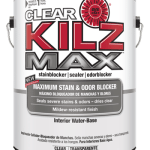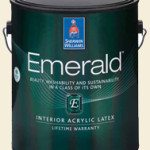When it comes to painting a house, the quality of the products used and their application can be the difference between a paint job that begins to crack and chip as soon as it’s done drying and one that can last decades. In fact, every step of the process of painting a house — the paint products, preparing the surface, the application — contributes to giving a structure a paint job that can weather many seasons. However, the first step is finding the right products to use. Here’s what you should know to help you choose the best paint products to paint a house.
Primer for Exteriors
 An important first step to painting is priming, which serves a variety of purposes. For one thing, primer helps paint to look more even and prevents it from looking blotchy or showing any possible colors you’re trying to cover up. Primer also helps paint to dry properly by giving it a smooth, consistent surface to which it can bind, making it more durable and able to last much longer. Painting over primer rather than the raw surface also helps minimize the unsightly bristle marks that your brush could leave behind in the dried paint.
An important first step to painting is priming, which serves a variety of purposes. For one thing, primer helps paint to look more even and prevents it from looking blotchy or showing any possible colors you’re trying to cover up. Primer also helps paint to dry properly by giving it a smooth, consistent surface to which it can bind, making it more durable and able to last much longer. Painting over primer rather than the raw surface also helps minimize the unsightly bristle marks that your brush could leave behind in the dried paint.
For painting on wood, primer will help to keep the wood from swelling when there’s excess moisture in the air, which will cause your paint to stretch and crack. The best woods for holding paint are redwood, baldcypress, white pine, red cedar, and sugar pine; however, lodgepole pine, hemlock, spruce, Douglas fir as well as red and southern pines do not hold paint as well and will require the use of very high-quality primer. It’s usually pretty easy to find out what wood is being used for newer constructions, but for older homes you may not always be able to tell. Going with a high quality, oil-based primer will improve the wood’s ability to hold paint regardless of the type of wood.
You should also consider the climate when choosing a primer to paint a home. In areas high in moisture, oil-based primers are preferred by most professionals. Some advocate applying a water-repellent when painting in moist, humid regions while also using primers that repel mold and mildew.
Paint for Exteriors
Like primers, there are different types of paint that you can use when you’re painting the exterior of a house. The main paint types available are oil-based paint and water-based latex paint.
Oil-based paint takes much longer to dry, but it tends to be much more durable. They also tend to have some of the highest adhesion of any paint. However, they tend to become very brittle over time and can also oxidize. Oil-based paint is best when painting surfaces that are “chalky” — a powdery substances comes off when you run your hand across the surface — as well as on most trim, when you’re painting on a surface that’s been painted over several times, and in areas of high moisture and humidity.
Water-based latex or acrylic paints, however, have great color retention, dry quickly, and clean up easily. They’re also more flexible — almost stretchy — than oil-based paints, which can make them better in some instances. Most professional will recommend the use of water-based latex paint on vinyl and aluminum, on wood, in areas that experience cold and freezing temperatures, and on new masonry.
There are many types and brands of paints available, it is best to work with a painting contractor or paint store expert to find the best product for your home.
Dane O’Leary
For more tips and tricks, visit Modernize.com.



You find present day exterior oil paint to be more durable than latex? Hmmmm. What brand of oil paint do you use? Not many manufacturers make it any longer because of VOC regulations.
Most sources recommend using latex much of the time with only a few instances where oil could be a better choice. For example, if an exterior has been painted numerous times, oil paint is considered a better choice if it’s covering many layers of paint under it. They’re also recommended for painting surfaces that are chalky, meaning if you wipe your hand over it you have a layer of dust on your hand. They also tend to hold their color very well.
The ability of latex to stretch makes it better for regions that are moist or have changing seasons with lots of hot and cold temperature extremes. Generally speaking, most people will probably be best off using acrylic/latex/water-based paint. It’s versatile, dries quickly, and can expand a bit with the wood underneath. With oil being available even in such limited supply I felt it worth mentioned its merits, but 90% of the time latex would be the better choice. And as you mentioned, latex is typically the “greener,” more environmentally and health-conscious option.
For contractors and professional painters, priming is just a given. But many homeowners don’t seem to see the value in it all the time…they see it as an “extra” step in the remodeling process as opposed to a requirement. We’ve taken on quite a few jobs where the previous job was just poor quality due to homeowners skipping this important step. Blotching and different shades bleeding through are just not professional.
Useful information given by writer, very rarely we encounter such a blog who gives genuine information. Thanks for sharing information about exterior paints and its techniques.
I’ve gotta say that the majority of problems I encounter here in Hawaii, where it is humid and fairly warm most of the year (80 mostly but up to 90 or so in summer) are with Oil based paint. I’m speaking primarily of Exteriors, where wood is expanding and contracting a lot. This is where Oil cracks. There are a few other reasons I can see for not using Oil Paint. One being that because of it’s hardness and slick finish, it is difficult to adhere to when re-painting. Sure, I suppose one could Prime, but I’m of the theory that more and more coats of Paint / Primer is not necesasarily a good thing. It seems to me that the thicker the build up gets, the more apt it is to start to warp and peel over time. Think of your Caulk gun… when it’s new and you get some caulk on it, it sticks like glue; but give it time, and before you know it, layers build up and it’s way more easy to just peel it off.
Another of the problems with Oil is the thought of it becoming extinct in the future with all the environmental movements happening. The types of Oil are already very limited compared to latex. I personally am partial to Heavy bodied Stain for new jobs. Stain almost never cracks or peels, is easier to apply, and acts as it’s own primer. My own house is over 60 years old and is amazingly preserved by Stain.
On another note, I would love to hear what people think regarding what they feel is better for new work as far as Primers is concerned; Oil or Latex. I’m most interested in longevity rather than ease of use (I hate working with Oil!).
I’ve asked this question in another place, but has anyone ever used Behr’s latex primer on Exteriors? As I recall, it was a thinner more absorbing Primer, which could be a good thing – acting like an Oil primer, seeping into the wood. Gripper or 1,2.3 tend to be thicker and sit on the surface more.
Finally, it Chalking is an issue, rather than priming with an Oil Primer, I like to use either Bond Prep from PPG (formerly Glidden or ICI Dulux) This is a thin, almost watery milky looking primer that dries clear and bonds the chalk. Super easy to apply with a back-pack sprayer, and very economical. A less economical but more readily available substitute is Peel Stop (original, not triple thick) which accomplishes the same thing. I have evan used it over Oil-based paint before Painting with Latex, and it seemed to work fine. Much easier than applying Oil Primer by Spray, Brush, or roller.
Painting products very important for a good painting, we have to choose correct paint, correct paint brush, and right painters if we not do it by own. Thanks for sharing information about exterior paints and its techniques.
Thanks for sharing this valuable information with us.
Question, do you know of any good painters in Winnipeg you could refer?
Rod Salm
Hi Rod, I don’t, but I am sure one of our readers will chime in soon.
Thanks for sharing helpful information about paints and its techniques.
A very helpful tips in choosing which paint to use.
It’s a good thing to read this kind of article, in that way it would be easier for me to choose the right paint.
Primer also helps paint to dry properly, that’s a good one fine tip for me.
I like this kind of article, it has its pricing and estimating section.
Will definitely expect for more blogs from you, a very interesting article.
Going with a high quality, oil-based primer will improve the wood’s ability to hold paint regardless of the type of wood. This will make your painting more effective.